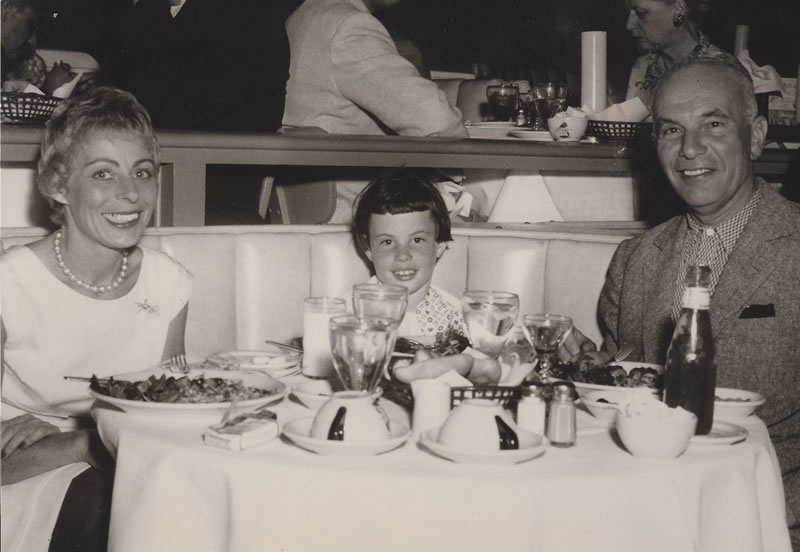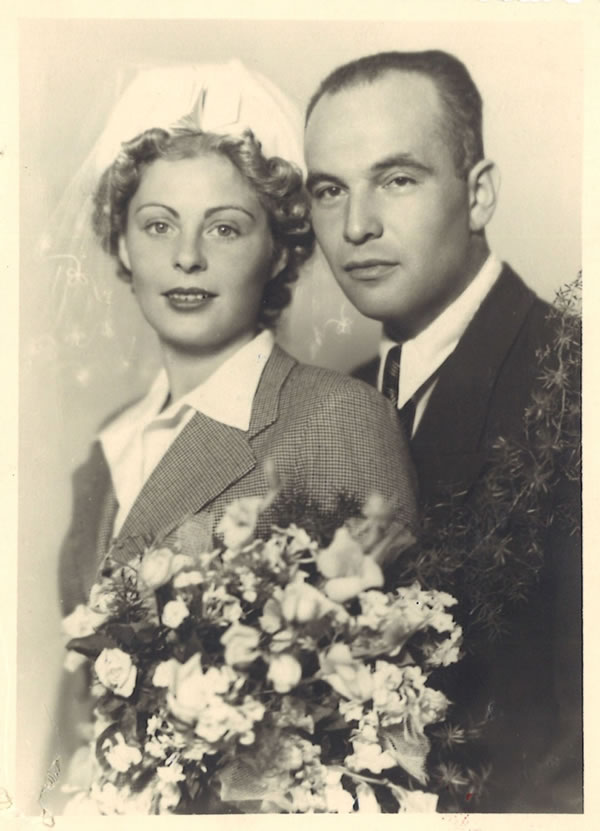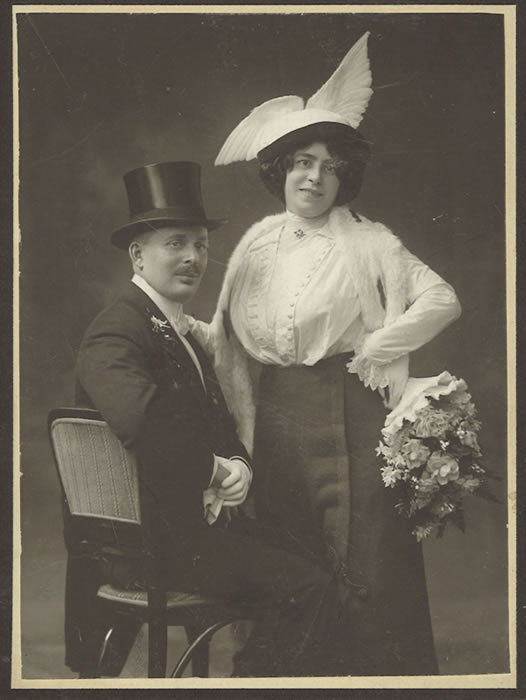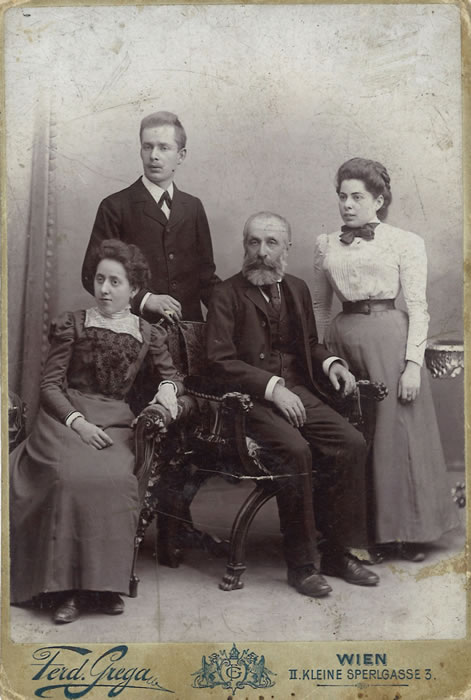Comedian, actress and author Ruby Wax has lived in London with her husband for some years, but was born and raised an only child in the United States of America. Her parents were Edmund Wachs and Berta née Goldmann and they left Vienna, Austria in the 1930s as the clouds of World War Two were gathering. Once settled in Chicago, Ruby’s father changed the way that the family surname was spelled from Wachs to Wax.

They were fleeing because they were Jewish and they took the war with them and brought it to our kitchen. Then, finally, when I was 18 I came to London because I needed safety. They escaped out of Europe and I escaped back into it again.
Ruby Wax became a well known face on British television and in the 1990s, when she was well established in her TV career in the UK, Ruby was diagnosed with depression and admitted to the Priory Hospital. Ruby has since gone on to be trained in cognitive behavioural therapy and mindfulness and seeks to promote better understanding of mental health issues.
I think that I have lived most of my life in a high anxiety state, and so I want to know where that came from…and I keep blaming my parents; it would be interesting to know who they’re blaming. And I won’t stop until I figure out how these people were made and who they were.
Going back almost 20 years Ruby made a discovery in the attic of her late parents’ house. It was the leather suitcase that her mother had carried with her from Austria as she fled from the Nazis. Inside there had been photographs, documents and letters and now Ruby wants to know who the people in the pictures were and who the writers of the letters, Ella and Salo, were. Unfortunately for Ruby she has limited German so she can’t read them herself.
Her parents had only ever told her fragmented stories of what they went through in Vienna. In the Who Do You Think You Are? episode Ruby describes her parent’s dysfunctional household. She explains how her mother had what was once referred to as “hysteria”. This caused her to scream disconnected thoughts “the language was nuts.” Her father, Ruby tells the viewers, was a volatile character.
He was…as she called him, a ‘torturer’. Obviously they must have had a hideous relationship.
Ruby is keen to discover why it was that her parents were like this:
Was it in their genes or was it something that happened to them?
To start her family history journey Ruby visits Vienna, where both her parents grew up. She wants to find out how they managed to get out. Ruby has little knowledge about her roots:
I have no feeling of being Jewish; it wasn’t really mentioned a lot. I don’t even watch films about the Holocaust.
What Ruby does know is that her father had been imprisoned by the Nazis and she has some of the correspondence from the time he was in jail during 1938.
I don’t really know how difficult it was to be a Jew here at that particular time.
Ruby’s father said that he had stowed away on a boat bound to America and made it seem like an adventure. She recalls that he had said that when he was in prison in Austria he was in charge of aerobics.
In the programme Ruby makes a trip to the prison to meet up with a historian. She is able to learn that her father had been imprisoned for at least 2 months from April 1938 this would have been just 6 weeks after Austria had been annexed by Germany. In the Anschluss, Hitler and his army entered Austria unopposed and were greeted by vast, adoring crowds. The consequence for Viennese Jews was immediate brutal attacks at the hands of Austrian Nazis. Ruby’s father was locked up simply because he was Jewish. Her parents had yet to marry and Ruby is surprised when she reads translations of her mother’s letters to her father in prison.
I had no idea that my mother loved my dad…saying that she cried every day…I had no idea that they really loved each other.
The story that he taught aerobics in the prison, turns out to be false. In fact Ruby’s father and fellow Jewish prisoners were tortured by their captors and made to perform humiliating and painful exercises. The experience led some to commit suicide.
My dad told me he was the aerobics coach; I didn’t understand that they were being tortured…it must have been wild! Why didn’t he tell me anything? What did he think my reaction would be?
A letter explains how her father managed to secure his release from the prison in July 1938 he had to promise to leave Austria. The alternative was to be sent to Dachau concentration camp. To avoid this and gain his release, he had to prove that he could leave Austria quickly. Vienna had, at this time, one of the largest Jewish populations of any European city and the official Nazi policy was to force as many jews as possible to leave the German Reich. Fearful of the number of refugees that would be flooding their borders, many countries restricted entry. Ruby’s father Edmund, however, was one of the lucky ones to have got an entry visa for Belgium and before he left, he hurriedly got married to Ruby’s mother Berta.
Ruby next meets a historian at the block of flats where her father had once lived before he was forced to flee. She learns that her father was able to get sufficient means together to pay for an expensive plane ticket to Belgium in September of 1938. From there, he did stow away, sneaking or bribing his way on board a boat bound for America. Ruby discovers that her mother Berta, who had a visa to go to America, left Vienna in December 1938. What this means is that Ruby’s mother would have still been in Vienna during Kristallnacht “the night of the broken glass” on the 9th-10th of November. This was a series of orchestrated attacks against Jewish businesses, homes and synagogues that took place all over the German Reich. The Jews that lived in Vienna were subjected to particularly brutal treatment: many were beaten and thousands were rounded up and arrested.
Access Over a Billion Records
Try a four-month Diamond subscription and we’ll apply a lifetime discount making it just £44.95 (standard price £64.95). You’ll gain access to all of our exclusive record collections and unique search tools (Along with Censuses, BMDs, Wills and more), providing you with the best resources online to discover your family history story.
We’ll also give you a free 12-month subscription to Discover Your Ancestors online magazine (worth £24.99), so you can read more great Family History research articles like this!
She never mentioned it. She never mentioned – ‘oh, by the way, I was there for Kristallnacht.’ Do you think that explains why she was out of her mind?

In her Who Do You Think You Are? programme Ruby walks along Tempelgasse and comes across the empty site of the Leopoldstadt Temple that had been completely destroyed during Kristallnacht. At one time this had been Vienna’s largest synagogue, and it was the place where Ruby’s parents had got married. Evaluating what she knows now about her mother’s experience, Ruby is saddened.
Clearly she was traumatised, but just give me a clue. One conversation. If she had broken down in tears and said ‘here’s what I left’ – I would’ve…my heart would’ve bled for her …I had no idea.
Ruby next investigates the letters from Ella and Salo dated 1941 that she has from her mother’s suitcase. She is keen to discover if they were relatives of hers and so to do this she meets up with a genealogist, who is able to shed some light on their relationship to her. Ella Birer, née Goldmann, has been identified as Gabriele, the sister of Ruby’s maternal grandfather Richard Goldmann. Ella being a short name for Gabriele while Salo was Salomon Birer, her husband. This couple were, therefore, Ruby’s great-aunt and great-uncle being the aunt and uncle of her mother Berta. With the aid of the genealogist, Ruby identifies her grandfather Richard Goldmann in one of the photographs that had been in her mother’s suitcase. They are also then able to put names to a family group in another that included her grandfather Richard, his older sister Ella (Ruby’s great-aunt), Richard’s younger sister Olga (another of Ruby’s great-aunts), and their father Salomon Goldmann (Ruby’s great-grandfather). All of these members of her family had died before the war, with the exception of Ella, who, with her husband Salo Birer, had sent Ruby’s mother the letters. At the time Berta had got to safety in America and her aunt and uncle were still in Vienna. The research showed that Ella was in her mid-60s by that time, while Salo was nearly 70. The two of them had been dental technicians before they retired and they had lived and worked from the same address.


Knowing where they once lived, Ruby visits Ella and Salo’s apartment/office where she is able to meet a historian who has been examining the letters written at a time when the War was already well underway. There is one letter to Ruby’s mother dated in August 1941 where Ella mentions that she and her husband are thin…and that she is learning to speak English. The situation for Jews in Vienna by this time was bad; they were denied many foods, including milk and eggs, and were only allowed to shop at certain restricted times. Jewish owned businesses had been seized or closed and their bank accounts were frozen. Worse still, the Nazis were rounding up and transporting Jewish people by train to the concentration camps. Ella and Salo would have been desperate to get a visa to leave Austria for America to escape that terrible fate. The mechanics of getting a visa required them to get an affidavit from their relatives in the USA to say that they would be given financial support. Ella wrote: “you can’t even imagine how afraid we are,“ and explained how she and Salo stayed inside, as every encounter outside was fraught with danger. The historian explains that getting an affidavit would have been a difficult task for them to obtain because of the US government’s requirements. It took Berta six weeks to get the affidavit sorted and sent to Ella but by that time the US had changed the rules and now required extra information to be provided. Unfortunately for them, in October, the Nazis then forbade all emigration out of the Reich.
I can’t imagine… a) being hungry and locked inside and b) going outside and people you know beating you up – and taunting you. I would have jumped out the window.
To discover what became of her great-uncle and aunt, Ruby makes a search of the Yad Vashem (the World Holocaust Remembrance Center) online database. This records what happened to Jews in WWII. Searching for Salomon Birer, Ruby sees that he was sent to Theresienstadt Ghetto, in Czechoslovakia and then sees:
‘Salomon was murdered in the Shoah.’ The Holocaust.
Ella is also recorded as murdered.
You know what’s good, is that I’m on medication…so that I don’t feel things as deeply as, um, maybe somebody else would. Now…20 years I’ve been on medication, so I’m really happy about that. Because this would’ve flipped me out.
Ruby is followed on the screen as she goes by train to the Czech Republic in search of answers about her great-aunt and uncle’s fate there. A historian, who takes her on to Theresienstadt, explains that when Ella and Salo arrived on the first transport from Vienna they would then have had to walk another 2.5 km from the station. Before the War, Theresienstadt had been a small town called Terezin that was surrounded by fortifications. The Nazis created a ghetto in 1941 and all the remaining Czech residents were forcibly moved out in 1942 to make room for the thousands of elderly Jews being transported there from the German Reich. While there were no gas chambers, jews were nonetheless murdered there; the conditions were so appalling that 33,000 prisoners died of disease and starvation. Some Jewish prisoners were, however, deported on from Theresienstadt to Auschwitz and Treblinka. Ruby finds out that her great uncle Salo had not survived, dying shortly after his arrival in Theresienstadt. What is not known is whether Ella died there as well, or was murdered later at one of the extermination camps.
Access Over a Billion Records
Subscribe to our newsletter, filled with more captivating articles, expert tips, and special offers.
I’m just happy that my great uncle died in a week. And then Ella…I hope she didn’t go to Auschwitz. But she died, and nobody knows where she died.
Ruby is keen to find out more about the other people in her Goldmann family photograph. To discover what she can about her grandfather Richard Goldmann, his father Salomon, and his other sister Olga all of whom she knows died before the War she returns to Vienna and the Central Cemetery. Ruby finds the overgrown plot of her grandfather and she discovers from reading the inscription on the headstone that it’s shared by her great-grandfather Salomon Goldmann, as well.
See the heartaching thing is – did my mother bury him? You sort of get the idea that this is like a bloodline that goes all the way to me, but nobody…nobody said anything. I wish my kids could see this
Ruby wants to then locate her great aunt Olga’s grave. With some help from the man who performs the Jewish burials at the cemetery she finds the burial plot. It is without a headstone but the burial record shows that Olga’s last address had been Am Steinhof. This turns out to be a psychiatric hospital in Vienna and it still stands to this day.
At the hospital Ruby meets a historian. Am Steinhof had been made up of a number of pavilions in Ruby’s great-aunt Olga’s time. The one in which she meets the historian had been reserved for “agitated” patients, though it is not known which pavilion Olga had been in. “Agitation” referred to behaviours that needed to be managed, including screaming which chimed with Ruby.
My mother did that: screaming in the street. See, I always wonder, was it Vienna? Or was it, you know, genes?
The Who Do You Think You Are? show reveals various treatments bath therapy, and work therapy. It is probable that Olga, who was a seamstress already, continued that work while at Am Steinhof where she died in 1933.
Ruby discovers that before Olga had been in this asylum, she had previously been resident in an asylum at Brno, which is now in the Czech Republic. The Goldmann family are traced having moved to Vienna from Moravia (now in the Czech Republic) and the Brno asylum was closest to that address. When the family came to Vienna, Olga was moved to Am Steinhof, having previously been in the Bruno institution for 5 years from 1903. She’d been institutionalised for most of her adult life, which points to her being deemed to be an incurable mental patient with a severe condition.
I asked originally ‘is there madness in my family?’ I thought: either madness or an actress, or both. So I got one.
She must have been howling here. And my mom did that at home. I bet my mother had what she had. You know it in every cell in your body: it’s only because I have a sense of humour that I’m not in this place.
In Brno, Moravia, in the Czech Republic, Ruby tries to find out more about Olga’s time there and so she meets a researcher at the Moravian Land Archive. Unfortunately, they hold no records for Olga, but there are other records that interest Ruby. She views a list of inmates in the Brno asylum from 1883-1894 and finds the surname Goldmann. With help, she deciphers the first name. It is not Olga but Bertha. This is Ruby’s great-grandmother and it transpires that Bertha Goldmann had been taken to the Brno insane asylum in 1884, 19 years before her daughter Olga was placed in the very same institution. Ruby reads a report in a newspaper that details that Bertha Goldmann had sold all her furniture and left her house expressing her intention to commit suicide in a written letter. Having been prevented from doing so and after just seven months inside the asylum, the 31 year old Bertha passed away having caught tuberculosis. All her children were less than ten at the time.
Well…my great grandmother and my great aunt were taken into the same asylum…I was going to say something funny, but I can’t….it’s not funny.
You know, I could have saved myself a lot of time and money. Rather than doing therapy I should have been doing genealogy. Now knowing my ancestors, I understand a lot more about myself.
Sources:
Press Information from IJPR on behalf of the programme makers Wall to Wall Media
Extra research and record images from TheGenealogist.co.uk
BBC Images






